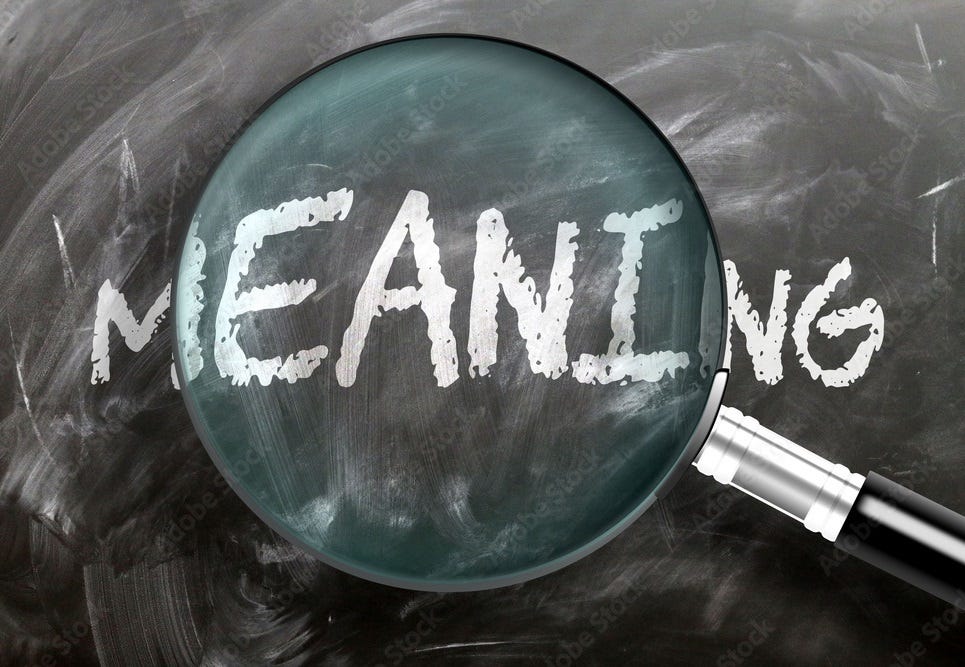1. A Universal Learning Process: The Basics
Energy, Entropy, and Information
This series is about the evolution of meaning.
But what, exactly, is meaning, anyway? What does it really entail for something to be meaningful? Is it something purely subjective, relative—just a matter of taste or opinion? Or is anything ever objectively meaningful, inherently meaningful, necessarily so?
Clearly, meaning matters to people. Psychological research over the past few decades has revealed a direct association between people’s sense of meaning in their lives and their overall health and well-being.[i] A perceived lack of it leads to pathology and, in extreme cases, suicide.[ii]
Meaning, then, has real existential import. But is this just a preoccupation of humans (perhaps only overly reflective, modern ones)? Or do other animals experience a sense of meaning? Is there meaning for a tree—or a rock?
What is the meaning of meaning?
A comprehensive treatment of the evolution of meaning invites a consideration of etiologies and origins. And while this series will focus primarily on human meaning and its transformations, I think it is vital to contextualize that focus by establishing the deep continuity that exists between human meaning and meaning more broadly. To that end, this first collection of posts will consider meaning in its most fundamental terms, then follow this throughline up to the domain of meaning in culture.
Here I will attempt an excavation of meaning to its deepest strata. Such an archeology can allow us to trace the idea of meaning back, far before human society, and even before animal cognition or biological evolution. Meaning, I will argue, arises out of the most fundamental dynamics of the physical world: energy and information. Indeed, bold as it may sound, it is precisely via the thermodynamic forces driving cosmic evolution as a whole that meaning evolves into more complex biological and social registers such as we experience as conscious agents.
Meaning is a particular kind of information—namely, information linking entities with their environments in ways that causally impact their viability and flourishing.
Meaning is “existential,” then, indeed. Beginning with a consideration of energy and information at the most basic level, we will turn to developments in information theory that have helped clarify the nature of meaningful information specifically. I will then track the implications of this idea into the big history frameworks that map cosmic complexification, arguing that meaning itself evolves through new emergent planes of existence—from matter to life to mind and on into culture.
As entities acquire meaningful knowledge through novel information processing systems at each of these levels, they engage in an ongoing learning process underway in the universe—a learning process, in fact, that characterizes all levels of cosmic evolution. After we get a sense of the full scope of this learning process, we can begin to zoom in on the cultural plane specifically to examine the evolution of human meaning, with particular attention to evolving conceptions of the sacred.
But first: the basics.
Energy and Information
There is a fundamental property of the universe that literally in-forms (i.e., gives form to) all known phenomena. This is the all-important Second Law of Thermodynamics.
According to this law, nature tends toward equilibrium and the homogenization of differences in the cosmos. Heat dissipates, gradients dissolve, and “things fall apart.” Distinct differences are inherently unstable and will face the natural push to even out—for, indeed, this “push” is precisely how energy does work.[iii]
Figure 1.1. Entropy[iv]
To picture this dynamic, consider what happens when you pour cream into your morning cup of coffee. It naturally diffuses, mixing with the coffee in the cup, so that the ordered distinction between “cream” and “coffee” gradually disappears, and both become inextricably mixed up.
This is akin to the way energy in a system will dissipate and yield to entropy.
This natural tendency towards homogeneity was given a statistical account by the physicist Ludwig Boltzmann, who showed that the spontaneous trend towards equilibration could be understood in probabilistic terms. That is, in a system with many possible microstates, highly ordered (e.g., concentrated) ones are simply far less likely than the vast range of ways they can be disordered.
Entropy in this sense can be understood as the gravitation towards randomness, and equilibrium arises when chance and probability are the only structuring pressures on a system.
Now, if this entropic drift were the only dynamic operating in the universe, no structures or complex phenomena would ever form; there would only be static equilibrium—forever. Fortunately, this is not the case. Instead, ordered structures can arise, but only if they are able to leverage the necessary energy to push back against the draw of entropy and maintain their improbable order.
Keep reading with a 7-day free trial
Subscribe to Brendan Graham Dempsey to keep reading this post and get 7 days of free access to the full post archives.





